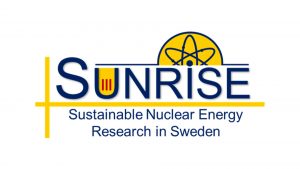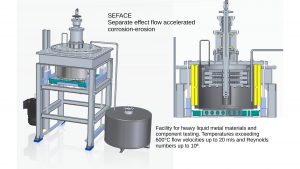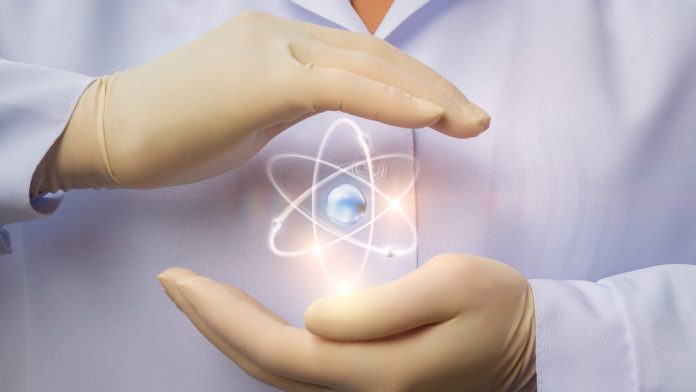Nuclear energy research, with a focus on small modular reactors, is rapidly advancing in Sweden, where new policy and changing political winds are acting as a positive driving force.
Nuclear energy is a key ingredient for a globally sustainable energy system. At KTH Royal Institute of Technology, there is a long tradition of research, innovation, and development of nuclear energy technology. KTH has the only currently running Master program in Nuclear Energy Engineering in Sweden, which is also jointly given as an international Master in the InnoEnergy EMINE framework and is operated by the Nuclear Engineering division of the Department of Physics at KTH. There is now an expected growth of both this programme and of nuclear engineering education and research activities in Sweden driven by an accelerating nuclear renaissance.
The energy crisis in Europe, which was steeply enhanced by the Russian invasion of Ukraine, has brought energy security and energy independence high on the political and societal agenda. In Sweden, which is already nearly carbon neutral in its electricity production, the large and ambitious infrastructure projects that are at the core of the Swedish national electrification strategy to transform industry and transportation will need massive amounts of electrical energy, as well as fossil-free process heat and hydrogen. The new Swedish government has recently announced an additional €25m for nuclear energy research over the coming three years. They have proposed abandoning the old politically motivated legislation that limits the number and location of nuclear power reactors, and they are staking out a roadmap for developing a sustainable energy system for the future. The attention from this industrial development has translated into higher demand for competence build-up, advanced education and for development and drive of state-of-the-art research programmes.
In recent years, research and innovation at KTH has been directed towards small modular reactors (SMRs) but in general, a broad range of topics is covered. The research covered comprises fundamental studies of radiation matter interactions, reactor physics, design and safety analysis of advanced reactors, development of advanced steels, nuclear materials science and radiation damage, nuclear fuel development, modelling, exposure and characterisation, testing and modelling of materials and components in high-temperature heavy liquid metals, development and optimisation of advanced Monte-Carlo methods and heat transfer in water up to the super-critical state.
The need for nuclear energy infrastructure
Nuclear energy research has a distinctive demand for experimental infrastructure that is necessary in order to progress. In many cases, infrastructure can be used jointly with other fields of science for optimal synergy. At KTH, nuclear energy researchers are utilising several materials synthesis and characterisation laboratories, where electron microscopy, spark plasma sintering, X-ray diffraction and other tools are carrying the heaviest load. Reactor technology research, studying fluid dynamics, heat transfer and mechanics can also benefit from central experimental infrastructures. For nuclear materials, and especially those containing actinides, or samples that have been irradiated, there is a dire need for specialised infrastructure that can handle the particularities of these materials. For uranium-bearing samples, often standard equipment can be used after contamination hazards have been taken care of, but for samples which may activate their environment or be of radiological concern, dedicated and radiation-shielded experimental facilities have to be used.
KTH hosts one of the two university laboratories in Sweden that works with nuclear fuel fabrication, exposure, characterisation, and analysis, but not with materials that are more active than unirradiated uranium. KTH also hosts dedicated severe accident laboratories that are used for both separate effect studies and integral tests with, for example, corium simulants. At Chalmers, there is a dedicated fuel laboratory that can handle active materials. Uppsala University hosts the national ion beam facility that is used for implantation, radiation damage studies and materials characterisation. The Luleå University of Technology hosts the Tribolab, which has a broad range of state-of-the-art tribological facilities. Nationally, Sweden is well placed to advance nuclear energy technology, but there is still no clear national research strategy that comprises support for critical infrastructures for the nuclear energy sector.
Nuclear energy research centres in Sweden

Currently, there are two major nuclear energy research centres in Sweden where the major technical universities collaborate and where the nuclear and materials science industry are active stakeholders.
The ANItA centre, opened in 2022 and hosted by Uppsala University, is a competence centre whose purpose is gathering academic and industrial nuclear technology competence in both technical and non-technical areas. The centre is initially financed by Swedish academia – in the form of KTH, Uppsala University and Chalmers University of Technology – the Swedish nuclear industry and the Swedish Energy Agency.
The goals of ANItA are to, through research and development, generate knowledge-based decision support aimed at the quick and safe implementation of new nuclear power technology in Sweden. This is to enable Sweden to become a completely fossil-free nation. Additional focus areas are generating new national nuclear technical expertise to ensure the safe operation of existing and future nuclear power facilities, sharing fact-based knowledge in the nuclear technology area, developing into a technical support organisation for politics, authorities and society at large, and creating good conditions for Swedish industry and social life to benefit from a good energy supply, allowing Swedish industry to become an important partner to international reactor suppliers. The ANItA centre is mainly working with water-cooled small modular reactor technology.
The SUNRISE centre at KTH in Stockholm, funded mainly by the Swedish Foundation for Strategic Research, was established in 2021 as a focused collaboration platform encompassing researchers from KTH, Luleå University of Technology, and Uppsala University. The centre also brings international university partners and a large fraction of the Swedish industry related to nuclear energy, materials science, and development together.
The main goal of SUNRISE is to develop and enable the deployment of lead-fast reactor technology. These reactor systems can act as the central part in a Generation IV closed nuclear fuel cycle – drastically reducing the high-level and long-lived waste – while providing safe, clean, and flexible energy. Research within the SUNRISE centre focuses on reactor physics and design, materials science and process technology, and combined experimental and modelling programmes to work towards establishing a lead-cooled research and demonstration reactor in Sweden. SUNRISE connects the three partner universities with a wide range of collaboration partners. Most strongly implied are LeadCold Reactors, Westinghouse Electric Sweden, and Alleima EMEA. However, SUNRISE also has seen involvement from Uniper, Jernkontoret, Promation, Outokumpu, Safetech, Vattenfall and Vysus Group who are industrial stakeholders, Oskarshamns municipality and the Swedish Radiation Safety Authority who both follow the development, and MIT in the US, Bangor University in the UK and UNSW in Australia who are international academic partners.
The work in SUNRISE is organised in five work packages. The first is focused on the design and safety analysis of the lead-cooled research reactor. The goal is to, with the support of external organisations, complete a Preliminary Safety Analysis Report (PSAR) of the reactor that may be submitted to the Swedish Radiation Safety Authority (SSM) as part of an application to build such a reactor if funding from other sources is obtained.
In the second work package on the development and modelling of advanced steels, alumina-forming steels and materials for pump impellers are developed and optimised, with the support of thermodynamical modelling. Test samples and component prototypes are manufactured for mechanical, erosion, and irradiation tests. Modelling of irradiation performance, embrittlement and interaction between lead and aluminium oxide is carried out using ab initio methods and multi-scale approaches.
In the third work package, we are developing and testing novel materials, coatings and manufacturing techniques. The main task is to qualify materials and processes to ensure the protection of components exposed to lead. Fretting tests of alumina-forming steels are performed in a high-temperature liquid lead environment at the Tribolab in Luleå. Spark plasma sintering of tungsten-based cemented carbides with minimal metallic bonding additives is developed and the solids will be exposed to harsh conditions, tested, and analysed. Laser welding of different alumina-forming steel overlays on advanced nuclear-grade austenitic cladding tubes is underway.
Fuel development is the focus of the fourth work package, where uranium nitride fuel pellets incorporating simulated fission products are manufactured using spark plasma sintering techniques. A range of porosities are produced to mimic the effect of bubble formation. Simulated fission products are introduced using a variety of methods, including such developed in the third work package. The degradation of fuel performance with burn-up is assessed by measurement of heat capacity, thermal diffusivity, thermal conductivity and thermal expansion of manufactured simfuel samples. Fuel-cladding and fuel-coolant interdiffusion experiments are carried out to determine the impact of fission products, and rod-leak tests will be conducted to assess the performance under accident conditions. Furthermore, a series of thermodynamic assessments of fuel-cladding-coolant systems will be made, feeding into the Thermodynamics of Advanced Fuels – International Database (TAF-ID) development organised by the OECD/NEA.
The final work package develops experimental testing facilities for components and materials in a lead-fast reactor environment. In this work package, several experimental test rigs are designed, built and used for testing and qualification of components for the research reactor. An erosion rig will be used for the qualification of pump impellers, as well as fuel cladding and steam generator tubes in prototypic lead flow regimes at temperatures up to 750°C. Separate effect tests will be carried out in a smaller-scale facility. Mock-ups using transparent liquids will be used for the validation of models predicting turbulent flow characteristics in facilities using liquid lead.
Recent breakthroughs from SUNRISE are the development of embrittlement-free corrosion and erosion tolerant alumina forming steels for use in lead fast reactors, the development of advanced modelling frameworks that can be used to perform high-dose irradiation simulations directly from first principles atomistics, and of novel mechanical and thermomechanical testing of advanced nuclear fuel structures, here uranium nitride and simulated burn-up fuels containing inactive fission product simulants. Dedicated infrastructures for materials exposure and testing are being commissioned and built at KTH in the frame of SUNRISE. Flow accelerated corrosion/erosion is a phenomenon of safety importance in lead fast reactors and SUNRISE researchers are constructing a facility that can be flexibly switched from separate effects studies with linear flow velocities from 0-20 m/s and Reynolds numbers up to one million, to long-term tests of critical components.

In collaboration with the University of New South Wales in Australia, SUNRISE is a critical partner on an application for neutron beam time at ANSTO, which was recently awarded a three-year programme access. This will enable deep characterisation of thermal, elastic, and mechanical properties of novel fuel and structural materials for a wide range of conditions through the use of neutron scattering.
The second step in the SUNRISE-initiated research and development programme, called Solstice, is the design, construction and operation of an electrically heated large-scale experiment facility that will be used to test materials, components, maintenance protocols, as well as planned and accident transients that can occur in an LFR. KTH, in collaboration with LeadCold and Uniper, has been awarded funding for the Solstice project from the Swedish Energy Agency to build the facility in Oskarshamn at the OKG nuclear power plant site. The facility will finalise the safety and performance study for the research and demonstration reactor designed in SUNRISE. The industrial partners in the Solstice project aim to assure the case for future commercialisation of lead-fast reactor technology. The strategic goal is to establish SMRs as a sustainable and safe solution for plannable and flexible base power, to make it part of a circular society. Being financially viable and scalable, the global market can be addressed with products and services like electricity, high-quality heat, hydrogen, biofuels, electro fuels, and ancillary services.
Advanced and sustainable nuclear reactors, with passive safety and manufactured in automated production, offer all benefits of conventional nuclear reactors but are substantially more versatile and flexible. Advanced SMRs can become the solution that enables an introduction of large-scale climate-neutral electricity production while being able to provide additional benefits for a sustainable society.
Please note, this article will also appear in the thirteenth edition of our quarterly publication.









